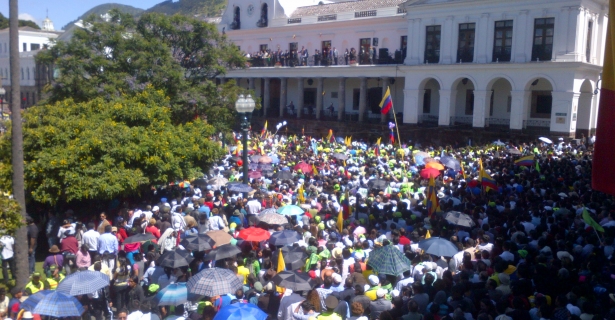June 2015 will be remembered as a historic month for Quito, and having the opportunity to learn about mobility in this particular context has been invaluable. Quito, the capital of Ecuador, is a city of about 1 million inhabitants nestled in a small valley surrounded by the Andes mountains. Its topography is complex, public transport scarce and the streets are often saturated as people from around the country flock to the capital. Mobility in the city has always been chaotic which is why it is a priority for the current Municipal administration. In this context, two important events have taken place this summer that have set a very interesting tone to my internship thus far.
The first one involves the two new laws President Correa introduced to the National Assembly for approval on June 5th. These laws, that address inheritances and the added value of land are highly controversial and have led the Ecuadorian citizenry to mobilize itself. Since that day, pro and anti-government protests (all peaceful) have taken place almost every day in multiple locations around the country. This movement has been the largest Ecuador has seen in decades. Because the Secretariat of Mobility is in charge of traffic in the city, these protests have represented a significant challenge as they block one of Quito's main avenues almost every night. As a result, much of my work has been to help design an action plan that ensures the safety of those protesting, while also minimizing their impact on traffic. Though planning traffic sounds simple, it is actually a complex process that involves the entire Secretariat's structure- from the Secretary himself to the traffic agent standing on the street corner- everyone has to be well coordinated and informed if the city is to flow. More often than not, at the office we draw a plan on the map, deciding which intersection to close, which streets to use as alternate routes and where to place traffic agents to warn people of the protests ahead, but by the time we arrive at the closed intersections to supervise, the situation is so vastly different than expected that we have had to develop a whole new plan on the spot.
The other factor contributing to Quito's chaos is Pope Francis' upcoming visit to Ecuador on July 4th. The Pope will be in Quito for 4 days, and everywhere he goes streets have to be closed. For example, on his way from the Airport to where he will be staying, there will be 47 closed intersections! On his third day in Quito, the Pope will be giving a public mass that over 2 million people are expected to attend (twice Quito's population) and half the city -I am not exaggerating- will be closed. No one is allowed to drive private cars since all major streets will be used to park buses and it is expected that only evacuating people after the mass ends will take about 8 hours. With regards to the Pope's visit, the Municipality not only has to plan transportation routes that ensures his safety and plan the closure of intersections and alternate routes for the entire city, but also has to provide public transport for 2 million people that will not be able to drive anywhere for 4 days. The Pope's visit has therefore involved a large effort where multiple Secretariat have collaborated to develop a plan of action. This plan has had to be approved by the national government, the Mayor, and different groups in society such as worker unions and inhabitants of neighborhoods that will be affected.

